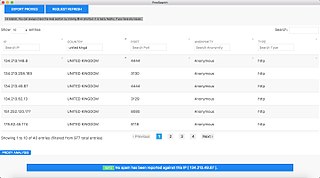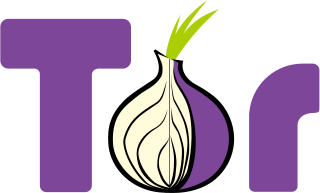See also
- Anonymous P2P
- Anonymization
- Private browsing
- I2P - the invisible internet project
- Java Anon Proxy - a proxy system designed to allow browsing the Web with revocable pseudonymity. [18]
- Geo-blocking
- Open proxy
- Tor (network)
An anonymizer or an anonymous proxy is a tool that attempts to make activity on the Internet untraceable. It is a proxy server computer that acts as an intermediary and privacy shield between a client computer and the rest of the Internet. It accesses the Internet on the user's behalf, protecting personal information of the user by hiding the client computer's identifying information such as IP addresses. [1] [2] [3] Anonymous proxy is the opposite of transparent proxy, which sends user information in the connection request header. [4]
There are many reasons for using anonymizers, such as minimizing risk, prevention of identity theft, or protecting search histories from public disclosure.
Some countries apply heavy censorship on the internet. [5] [6] [7] [8] [9] Anonymizers can help to allow free access to all of the internet content, but they cannot help against persecution for accessing the anonymizer website itself. Furthermore, as information itself about anonymizer websites are banned in those countries, users are wary that they may be falling into a government-set trap. [10]
Anonymizers are also used by people who wish to receive objective information with the growing target marketing on the internet and targeted information. For example, large news outlets such as CNN target the viewers according to region and give different information to different populations. Websites such as YouTube obtain information about the last videos viewed on a computer, and they propose "recommended" videos accordingly, and most of the online targeted marketing is done by showing advertisements according to that region. Anonymizers are used for avoiding that kind of targeting and getting a more objective view of information. [11]
For building a reliable anonymous system, anonymous proxy signatures are helpful. [12] It can be used in anonymous voting or other authentication processes that value anonymity. [12]
Sometimes anonymizers are implemented to work only with one particular protocol. The advantage is that no extra software is needed. The operation occurs in this manner: a connection is made by the user to the anonymizer. Commands to the anonymizer are included inside a typical message. The anonymizer then makes a connection to the resource specified by the inbound command and relays the message with the command stripped out.
An example of a protocol-specific anonymizer is an anonymous remailer for e-mail. Also of note are web proxies and bouncers for FTP and IRC. Potentially anonymity integrated with RFID tags could pose as an option. [13]
Protocol independence can be achieved by creating a tunnel to an anonymizer. There are various technologies to do so. Protocols used by anonymizer services may include SOCKS, PPTP, or OpenVPN.
In this case either the desired application must support the tunneling protocol, or a piece of software must be installed to force all connections through the tunnel. Web browsers, FTP and IRC clients often support SOCKS for example, unlike telnet.
Proxies can be daisy chained. Chaining anonymous proxies can make traffic analysis far more complex and costly by requiring the eavesdropper to be able to monitor different parts of the Internet. [1] An anonymizing remailer can use this concept by relaying a message to another remailer, and eventually to its destination.
Even stronger anonymity can be gained by using Tor. Tor is not merely a proxy chain, but an onion router, which means that routing information (as well as message content) is encrypted in such a way as to prevent linking the origin and destination. Like all anonymity networks, Tor cannot end-to-end encrypt messages destined for the public internet; [14] it must be arranged between the sender and recipient. Tor's onion service protocol does, however, provide end-to-end encryption, along with the ability to anonymize servers, making them more censorship-resistant.
Another anonymity network is the Invisible Internet Project (I2P). Unlike Tor, I2P is a fully internal network. The philosophy behind I2P is that each node routes traffic for others and blends its own traffic in, whereas one's own traffic will be relayed by other peers through so-called tunnels made up of various other peers. As you never know if a given mix logs all connections or not, the only way to be really sure there is no logging is to run your own anonymizing mix node and blend your traffic with those of other users. These other users do not need to trust you, as they blend their traffic with yours and other users' traffic in their own mix nodes. The network is highly dynamic and fully decentralized. It also takes care of other nodes learning about your node existing, for without peers using your node, there would be no traffic to blend yours with. As all traffic always stays within the I2P network, a routing user's I2P can remain end-to-end encrypted and will never show on public websites' logs. [15]
Examples of anonymizer websites include Anonymouse, Anonymiz.com, Anonymize, Anonymizer, IDZap, Ultimate Anonymity, The Cloak, GoTrusted and GhostSurf Platinum. [16] Websites such as GoTrusted.com and Anonymizer.com offer users internet access with anonymity through the payment of a subscription fee. Users pay to route their online traffic through the companies' servers, typically using a VPN. [17]

Hyphanet is a peer-to-peer platform for censorship-resistant, anonymous communication. It uses a decentralized distributed data store to keep and deliver information, and has a suite of free software for publishing and communicating on the Web without fear of censorship. Both Freenet and some of its associated tools were originally designed by Ian Clarke, who defined Freenet's goal as providing freedom of speech on the Internet with strong anonymity protection.
An anonymous remailer is a server that receives messages with embedded instructions on where to send them next, and that forwards them without revealing where they originally came from. There are cypherpunk anonymous remailers, mixmaster anonymous remailers, and nym servers, among others, which differ in how they work, in the policies they adopt, and in the type of attack on the anonymity of e-mail they can resist. Remailing as discussed in this article applies to e-mails intended for particular recipients, not the general public. Anonymity in the latter case is more easily addressed by using any of several methods of anonymous publication.

In computer networking, a proxy server is a server application that acts as an intermediary between a client requesting a resource and the server providing that resource. It improves privacy, security, and performance in the process.
A pseudonymous remailer or nym server, as opposed to an anonymous remailer, is an Internet software program designed to allow people to write pseudonymous messages on Usenet newsgroups and send pseudonymous email. Unlike purely anonymous remailers, it assigns its users a user name, and it keeps a database of instructions on how to return messages to the real user. These instructions usually involve the anonymous remailer network itself, thus protecting the true identity of the user.

Onion routing is a technique for anonymous communication over a computer network. In an onion network, messages are encapsulated in layers of encryption, analogous to the layers of an onion. The encrypted data is transmitted through a series of network nodes called "onion routers," each of which "peels" away a single layer, revealing the data's next destination. When the final layer is decrypted, the message arrives at its destination. The sender remains anonymous because each intermediary knows only the location of the immediately preceding and following nodes. While onion routing provides a high level of security and anonymity, there are methods to break the anonymity of this technique, such as timing analysis.
An anonymous P2P communication system is a peer-to-peer distributed application in which the nodes, which are used to share resources, or participants are anonymous or pseudonymous. Anonymity of participants is usually achieved by special routing overlay networks that hide the physical location of each node from other participants.
Traffic analysis is the process of intercepting and examining messages in order to deduce information from patterns in communication. It can be performed even when the messages are encrypted. In general, the greater the number of messages observed, the greater information be inferred. Traffic analysis can be performed in the context of military intelligence, counter-intelligence, or pattern-of-life analysis, and is also a concern in computer security.
The Invisible Internet Project (I2P) is an anonymous network layer that allows for censorship-resistant, peer-to-peer communication. Anonymous connections are achieved by encrypting the user's traffic, and sending it through a volunteer-run network of roughly 55,000 computers distributed around the world. Given the high number of possible paths the traffic can transit, a third party watching a full connection is unlikely. The software that implements this layer is called an "I2P router", and a computer running I2P is called an "I2P node". I2P is free and open sourced, and is published under multiple licenses.
A dark net or darknet is an overlay network within the Internet that can only be accessed with specific software, configurations, or authorization, and often uses a unique customized communication protocol. Two typical darknet types are social networks, and anonymity proxy networks such as Tor via an anonymized series of connections.
Secure communication is when two entities are communicating and do not want a third party to listen in. For this to be the case, the entities need to communicate in a way that is unsusceptible to eavesdropping or interception. Secure communication includes means by which people can share information with varying degrees of certainty that third parties cannot intercept what is said. Other than spoken face-to-face communication with no possible eavesdropper, it is probable that no communication is guaranteed to be secure in this sense, although practical obstacles such as legislation, resources, technical issues, and the sheer volume of communication serve to limit surveillance.

Java Anon Proxy (JAP) also known as JonDonym, was a proxy system designed to allow browsing the Web with revocable pseudonymity. It was originally developed as part of a project of the Technische Universität Dresden, the Universität Regensburg and Privacy Commissioner of the state of Schleswig-Holstein. The client-software is written in the Java programming language. The service has been closed since August 2021.

A proxy list is a list of open HTTP/HTTPS/SOCKS proxy servers all on one website. Proxies allow users to make indirect network connections to other computer network services. Proxy lists include the IP addresses of computers hosting open proxy servers, meaning that these proxy servers are available to anyone on the internet. Proxy lists are often organized by the various proxy protocols the servers use. Many proxy lists index, which can be used without changing browser settings.
Peer-to-peer file sharing (P2P) systems like Gnutella, KaZaA, and eDonkey/eMule, have become extremely popular in recent years, with the estimated user population in the millions. An academic research paper analyzed Gnutella and eMule protocols and found weaknesses in the protocol; many of the issues found in these networks are fundamental and probably common on other P2P networks. Users of file sharing networks, such as eMule and Gnutella, are subject to monitoring of their activity. Clients may be tracked by IP address, DNS name, software version they use, files they share, queries they initiate, and queries they answer to. Clients may also share their private files to the network without notice due to inappropriate settings.
Garlic routing is a variant of onion routing that encrypts multiple messages together to make it more difficult for attackers to perform traffic analysis and to increase the speed of data transfer.
Anonymizer, Inc. is an Internet privacy company, founded in 1995 by Lance Cottrell, author of the Mixmaster anonymous remailer. Anonymizer was originally named Infonex Internet. The name was changed to Anonymizer in 1997 when the company acquired a web based privacy proxy of the same name developed by Justin Boyan at Carnegie Mellon University School of Computer Science. Boyan licensed the software to C2Net for public beta testing before selling it to Infonex. One of the first web privacy companies founded, Anonymizer creates a VPN link between its servers and its users computer, creating a random IP address, rather than the one actually being used. This can be used to anonymously report a crime, avoid spam, avoid Internet censorship, keep the users identity safe and track competitors, among other uses.

Phex is a peer-to-peer file sharing client for the gnutella network, released under the terms of the GNU General Public License, so Phex is free software. Phex is based on Java SE 5.0 or later.

Tor, short for The Onion Router, is free and open-source software for enabling anonymous communication. It directs Internet traffic via a free, worldwide, volunteer overlay network that consists of more than seven thousand relays.
Invisible mail, also referred to as iMail, i-mail or Bote mail, is a method of exchanging digital messages from an author to one or more recipients in a secure and untraceable way. It is an open protocol and its java implementation (I2P-Bote) is free and open-source software, licensed under the GPLv3.
Internet censorship circumvention, also referred to as going over the wall or scientific browsing in China, is the use of various methods and tools to bypass internet censorship.
A wireless onion router is a router that uses Tor to connect securely to a network. The onion router allows the user to connect to the internet anonymously creating an anonymous connection. Tor works using an overlaid network which is free throughout the world, this overlay network is created by using numerous relay points created using volunteer which helps the user hide personal information behind layers of encrypted data like layers of an onion. Routers are being created using Raspberry Pi adding a wireless module or using its own inbuilt wireless module in the later versions.
{{cite news}}: CS1 maint: unfit URL (link)